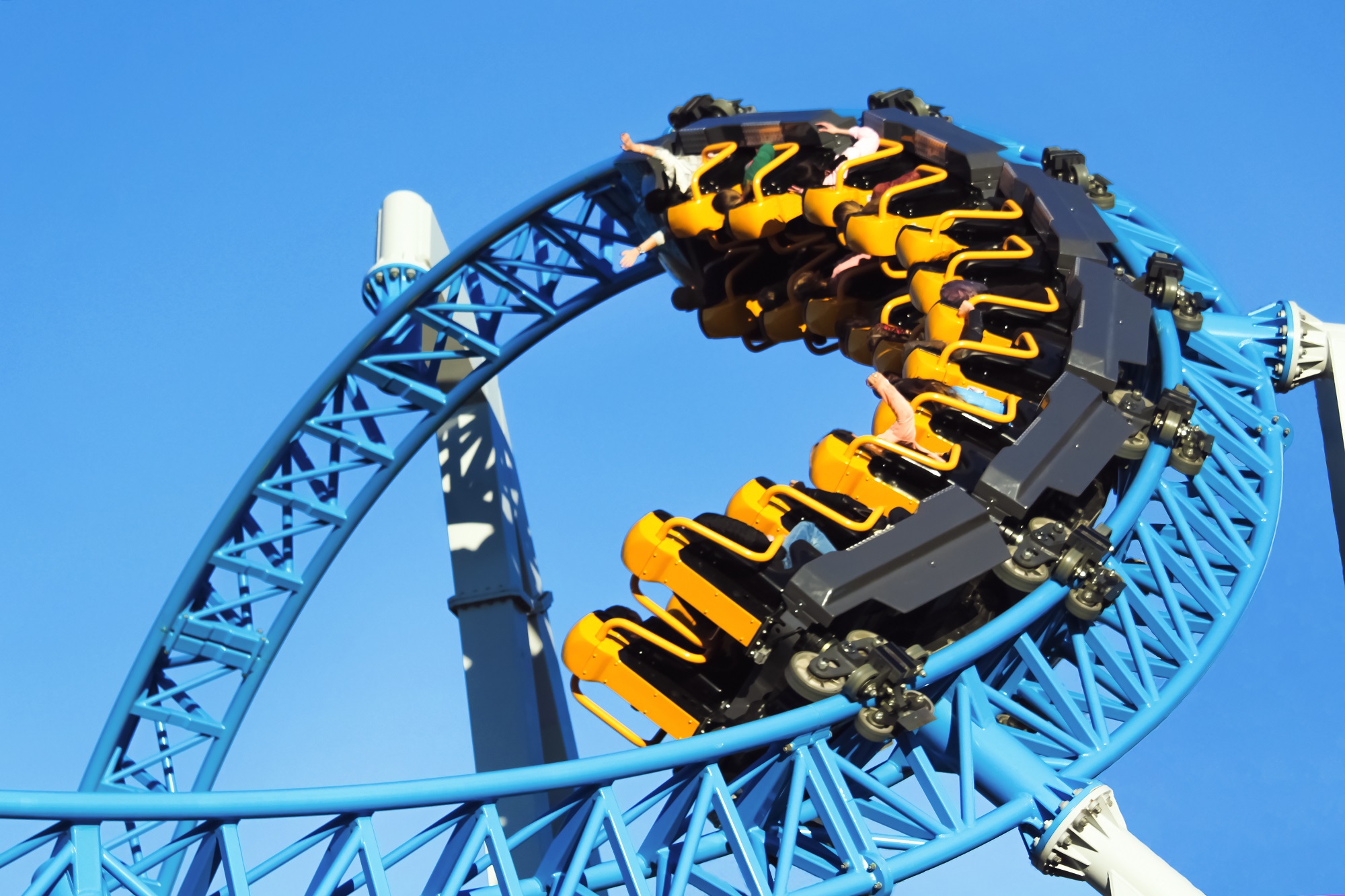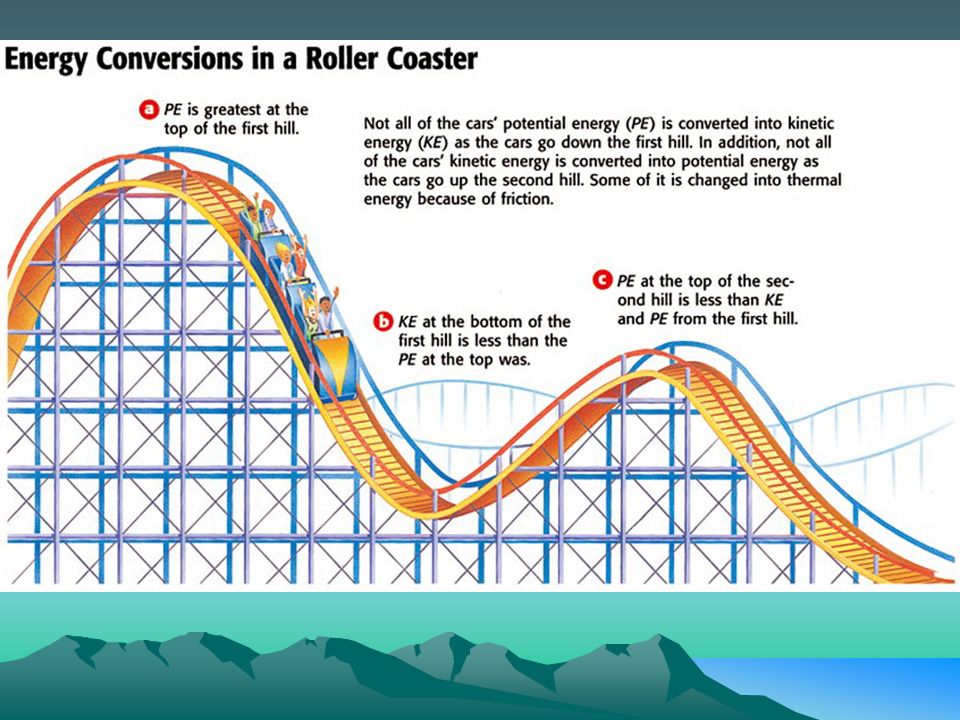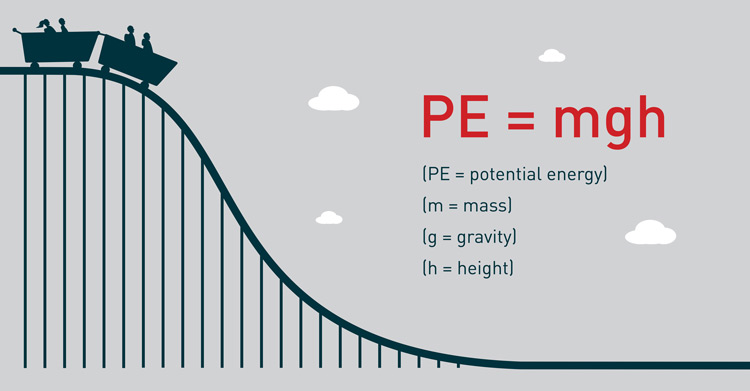Written by Robin Adair, Dec 17th 2020

Rollercoasters offer a thrilling and enjoyable ride for many thrill seekers out there in the American world. But many might wonder, what are these machines, and where did they come to be? Rollercoasters are devices that are powered by not only kinetic and potential energy, but also how to store and provide it. While many thinks of the thrills and the chills of the wind screaming down their face as they ride down there is actually quite a lot behind rollercoasters and their history. Rollercoasters use multiple angles of physics from energy, to inertia and gravity to keep the rides going (Library of Congress).
Roller coasters are often a exciting and thrilling highlight of summer! For many a adventurous ride seeker at the theme park waiting to do nothing more than watch as people scream and cheer. They might seem to be a simple novelty, and yet, there's quite a lot behind the scenes. Both in physics and mathemetics, but for now a little history! Can you guess which Country Rollercoasters came from? Perhaps, the bright and inventive USA? Nope! How about France or England, nope! The origin of Roller coasters actually, is not the USA or europe or another country, but 16th century Russia!
However, what really set off the popularity of rollercoasters would soon follow not only from world fairs, but worldwide fame. Yet at the same time they while seeming to be easy to think of as nothing more than a fun and exciting summer thrill. We can come to learn more and appreciate them for the intricate and detailed understanding that goes behind designing them.
Both of the engineering work that goes into them, but also the hard work and understanding of physics and mathematics that can go into designing them! While being extremely fun and thrilling these forces behind them help to connect the thrilling motion of the rollercoasters with the classroom with a topic I hope you can enjoy! Rollercoasters offer riders a way to briefly enjoy thrills such as temporary weightlessness, or loop de loops while enjoying great and exhilaration applications of physics, motion and inertia (Mandelbaum, 2016).
While there are many more subjects, (such as G forces, motion, inertia and friction), today we will focus most on the applications of kinetic and potential energy in our demonstrations.

Rollercoasters have made their way into the American heart as fun and exciting thrill rides and a staple of summer. From County fairs to coney islands, these amusement park rides have been capturing the attention and fondness of many people across the globe. Every year more than 300 million people used ride the roller coasters at our American amusement parks alone, yet where did they come from and why do people love them so much?
Roller coasters origin can trace their family tree's roots way back to the 16th century, but not the Americas like you might have been wondering and thinking, but 16th century Russia itself! Where wood framed ice slides sent riders down 70-foot slopes in addition to wheeled carts and wooden ramps. (Casper, 2018). Riders went crazy for the brand-new thrilling rides and spectacles you could get at the fair! Since then, rollercoasters have gone from being made out of wooden frames, to steel coasters and innovations from loop de loops to upside down turns and some inverted rollercoasters that hold you upside down from above as they flip you over all sorts of attractions!
At a simple level, it might seem to be simple to appreciate a roller coaster for what they are, a fast and thrilling and exhilarating ride. However, a lot goes behind them, from the engineering to the physics behind them that connects them to the mathematics and technology we use in our classrooms.
For instance, while roller coasters might seem to be simple devices of speed and fun, they actually have to use gravity and inertia to send the rides off in lots of interesting ways. The ideas behind these can also trace their roots and ideas back to the 16th century Russian Sleds. Some might even argue, what's the difference in ideas between the Russian sleds riding down on the slope of a snow-covered hill, vs the iron lined tracks and slopes of a coaster?
Rollercoasters allow us to access parts of the world in a way we normally wouldn't sliding down the hills of a summer sky, yet they bear some similarities to the 16th century coasters and sled rides many a kid once enjoyed zipping down the hills. Yet, while deceptively simple, there can actually be a lot about how they work behind the scenes! Have you ever wondered how a rollercoaster works? Why does it seem like the highest and steepest rollercoasters are the fastest and thrilling? Why do we speed up and down as we go up and down the path? Are you ready to find out? Keep reading ahead!

The secret behind Rollercoasters is the power of Physics. More specifically, Potential energy (Often shortened to PE), and Kinetic energy (PE). You see, gravity is a force that pulls on us at all times. You may ask, But, how can potential energy make a rollercoaster move? It starts off stationary, doesn't it?� And that's partially true. Potential energy itself isn't what necessarily starts the rollercoaster moving itself just from height. Gravity does. Although we tend to stay in one place on the ground, if you hold a pencil midair and drop it, what happens? Gravity will pull on the object, and proceed to have the object fall down.
The same happens with Roller coasters! Roller coasters are able to convert potential energy into kinetic energy as the riders ride down the slopes! By carrying the Riders up to the top, we build up height, which in turn, increases our Potential energy! Then, by releasing the rollercoaster in a state of semi freefall on the ramps, gravity will pull down on our coaster, accelerating and it giving the coaster the rapid acceleration it needs to clear loop de loops and fly through the scene on nothing but potential energy converted to kinetic energy via gravity's natural acceleration! Utilizing physics, rollercoaster designers are able to offer fun and thrilling rides to their consumers! But how does each part all come together you say?
Well when the rollercoasters climb the tracks, they maximize their Potential energy as they climb to the peak of the point, (often from a ride conveyor or system to pick them up!) As the device lifts the passenger car to the top it helps to build up height while in turn the conveyors do the work of elevating the system. Thus this allows us to store our Potential energy. Although normally in a closed system the inputs and outputs of our Total energy tend to stay equal, this lift system lets us inject some extra vigor into the solution!
There's a precise formula for the potential energy, being PE = mgh, where PE represents the Potential energy, M = the mass, g = the gravity, and h = height, and Kinetic energy. Every single time the height doubles, we can build up twice the potential energy! And when it comes time to convert it into Kinetic energy. Which is KE = ½ * m*v^2 where m = mass and V = Velocity, that doubled kinetic energy can allow us to go even faster than before! But notice, that it's not a fully 2x faster conversion, as v^2 is squared. So, in order to double our velocity twofold, we just need to simply square the speed increase we want, such that 2^2 = 4, and increase our height by four times! A lot easier said than done for sure! But for some of the skyscraper sized coasters, nothing ever can beat the thrill!

You can demonstrate this at home for instance if you want! For example, when you drop a toy car (One such as a matchbox or Hot wheels etc. will do!) from your hand. At first, the toy car has no velocity, but it rapidly will start to accelerate until it hits the bottom of the system, (etc. the floor!). But, put it on say for instance something like a toy plastic ramp or a curved slope, and you can see it speed up much faster from the higher it starts from until it reaches its terminal velocity! Thus, while you did not exert any direct force on the toy car after it left your touch, it was able to convert it's height into potential energy and then into kinetic energy. Thus, by utilizing physics, we can demonstrate how objects such as both rollercoasters or objects with mass are able to apply these same concepts to gain velocity from height. (CoasterForce).
In an ideal, closed loop energy system, the total energy of a system should be PE + KE = Total energy. However, within these idealized systems, we often assume that energy is completely 100% conserved, but that is not always true. There are also other forces such as energy loss due to wind resistance, friction as well. However, for the sake of simplification (as friction forces can vary dramatically, based on materials, smoothness, and friction coefficents. This lets us model the total energy of the system as TE = KE + PE!
(Key: M = Mass (kg), V = Velocity (Meters/seconds), h = Height(Meters), TE = Total energy(N), PE = Potential energy(N), KE = Kinetic Energy(N) )
Mess around with the Applet above! What happens to the Total Energy when you double the mass? How much height does it take to match PE if you double the velocity?
Experiment and have fun, etc!
Rollercoasters apply the concepts of physics such as potential and kinetic energy to design fun and thrilling rides with the height, while also needing to account for strain on the human body and also ensuring a ride's safety to passengers. Thus Rollercoasters offer both a fun and thrilling problem for many a interested student everywhere (Gaal, 2017). While Rollercoaster G forces are generally recognized as generally safe, some concerns have risen over the speed of coasters as care must also be taken, not only to make the rides fun and thrilling, but to also make them safe and enjoyable for the passengers!
Rollercoasters are able to feature speeds matching almost as high as pilots as the rollercoasters bank when they or the airplanes can make sharp maneuvers. Forces on a rollercoaster can be as much as 5-9 G, or 5-9x the gravity we feel upon earth! However, the forces upon a coaster goer often last under 3 seconds, while the forces upon a pilot can last for up to 43 seconds. However, Researchers worry about not only g forces, but rapid head acceleration, the rotational force on the brain that occurs when the body quickly changes directions. (University of Pennsylvania, 2002)
But simply creating a rollercoaster that goes fast isn't simply enough! In order to remain safe, a ride must have safe G forces and ensure that no riders could accidentally be hurt or launched out of the seat! Indeed, some rollercoaster parks in the quest to make the tallest and faster rollercoasters have made designs that went so fast, they were unsafe to ride and launched sandbags right out of the seat!
Thus, in order to maintain a safe ride, not only do the engineers behind a rollercoaster ride need to ensure a fun and thrilling experience, but it must also be safe on the human body and friendly or else the ride could risk being closed down or sued! So rides must also account for human factors as well. A normal human can handle about no more than 5Gs for a few minutes, 3Gs for a hour, and 9 Gs for only a few seconds (nearly 9x earth's normal gravity!)
Our bodies feel acceleration in funny ways as we ride down the coasters as the rides speed up or slow down, we in turn feel the same actions as we ride in the coasters while we continue to ride upon them itself. The forces such as G forces that we feel on Rollercoasters thus in turn offers a fun and exhilarating and enjoyable way for students to apply physics and mathematics to a enjoyable topic and even possibly make their own! While we have to be careful of the forces we put on people, there's no limit to what you can do in class! You can apply these teachings ranging from having students building their own marble or Hotwheel coasters, or putting a egg on a cart seeing how fast you could get it to run (without breaking the egg in it!). Rollercoasters allow us to visualize the fun concepts of kinetic and potential energy, as well as demonstrating Newton's Law of the Conservation of Energy in our systems.(Harris, 2018)